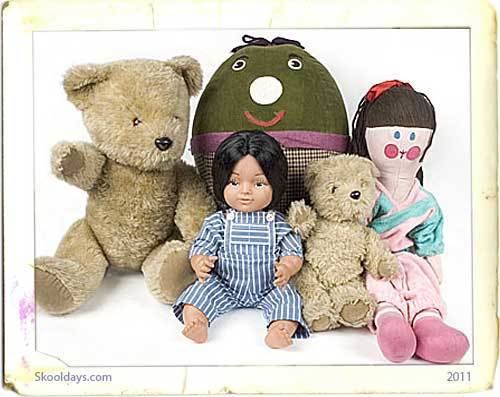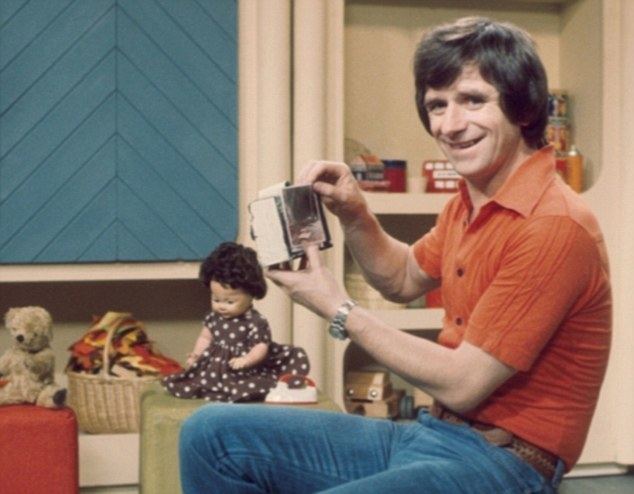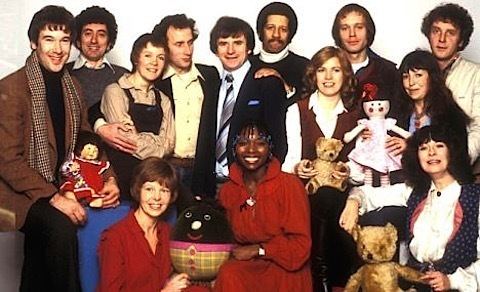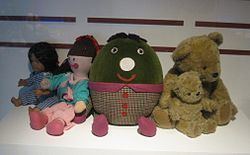7 /10 1 Votes
6.3/10 TV Country of origin United Kingdom First episode date 21 April 1964 Program creator Joy Whitby Writers Joy Whitby | 7.6/10 IMDb Created by Joy Whitby Original language(s) English Final episode date 14 October 1988 Networks BBC, BBC Two | |||||||||||||||||||||||||||||||||
 | ||||||||||||||||||||||||||||||||||
Genre Children's television series Executive producer(s) Cynthia Felgate (1972-1983) Original network BBC Two
also BBC One from 1983 Cast Brian Cant, Floella Benjamin, Derek Griffiths, Johnny Ball Similar Play Away, Playdays, Crackerjack, Multi‑Coloured Swap Shop, Jackanory | ||||||||||||||||||||||||||||||||||
Play School was a British children's television series produced by BBC Two (1964-1983) and later on BBC One (1983-1988) which ran from 21 April 1964 until 11 March 1988 (repeats until 14 October 1988). It was created by Joy Whitby. Play School originally appeared on weekdays at 11am on BBC2 and later acquired a mid-afternoon BBC1 repeat. The morning showing was transferred to BBC1 in September 1983 when BBC Schools programming transferred to BBC2. It remained in that slot even after daytime television was launched in October 1986 and continued to be broadcast at that time until it was superseded in October 1988 by Playbus, which soon became Playdays.
Contents
- Overseas sales and adoption
- Presenters
- Celebrity storytellers
- Musicians
- Toys
- Pets
- Contents of the show
- References

When the BBC scrapped the afternoon edition of Play School in September 1985, to make way for a variety of children's programmes in the afternoon, a Sunday morning compilation was launched called Hello Again!.

There were several opening sequences for Play School during its run, the first being "Here's a house, here's a door. Windows: 1 2 3 4, ready to knock? Turn the lock - It's Play School." This changed in the early seventies to "A house with a door, 1 2 3 4, ready to play, what's the day? It's..." In this version blinds opened on the windows as the numbers were spoken.

The blinds were no longer featured towards the end of the 1970s and the word "windows" was added before "1 2 3 4". The final opening sequence involved a multicoloured house with no apparent windows. This was used from 1983 until the end of the programme. This saw the most radical revamp of the programme overall (not just in the opening titles). The opening legend then became "Get ready. To play. What's the day? It's..."
Presenters included the first black host of a children's show, Paul Danquah; Brian Cant, who remained with the show for 21 years; actress Julie Stevens; former pop singers Lionel Morton and Toni Arthur; husband and wife Eric Thompson and Phyllida Law; Italian model and actress Marla Landi; and Balamory producer Brian Jameson. Don Spencer and Diane Dorgan also appeared on the Australian version. Play School and another BBC children's television programme Jackanory were sometimes recorded at BBC Birmingham or BBC Manchester when BBC Television Centre in London was busy.
Overseas sales and adoption
Play School was sold to Australia, and was then followed by local production. the Australian version has been produced since 1966. Similarly New Zealand bought the programme before producing their own from 1972-82 & 1986-89. The Canadian adaption was Polka Dot Door and ran from 1971-93.
Other countries including Norway (1971-81), Switzerland, Austria, Italy, Spain (1971-74), and Israel were provided with scripts and film segments so they could produce their own versions.
Sesame Street was a derivative of Play School, adopting their "strong visual style, fast-moving action, humor, and music".
Presenters
The first show was presented by Virginia Stride and Gordon Rollings. Other presenters throughout the 24-year run included
Only four of these presenters presented the programme during all three decades of its existence, namely Brian Cant (1964-85), Carol Chell (1966-88), Johnny Ball (1967-84 & 1986-87) and Chloe Ashcroft (1969-88). Chell was the both the longest-serving presenter and the one who made the most appearances on the programme (763 in total). Other presenters who were on the programme for 10 or more years included Julie Stevens, Derek Griffiths, Fred Harris, Don Spencer, Sarah Long, Floella Benjamin, Stuart McGugan and Carol Leader.
In many cases five programmes would be produced in the space of two days, with one day of rehearsal and one day of recording.
Celebrity storytellers
A number of famous people also appeared on the show as storytellers: many became semi-regulars. They included: Val Doonican, Richard Baker, Rolf Harris, Clive Dunn, Roy Castle, Pat Coombs, David Kossoff, Patricia Hayes, Sam Kydd, James Blades, Frank Windsor, Roy Kinnear, Ted Moult and Cilla Black. Both existing and former Play School presenters also frequently made guest appearances as storytellers.
Musicians
Many talented musicians worked on the programme over the years: they included Jonathan Cohen, William Blezard, Peter Gosling, Alan Grahame, Paul Reade, Spike Heatley, Alan Rushton, Anne Dudley and Peter Pettinger. Some of them, in particular Cohen, Gosling, Grahame and Reade, occasionally appeared on camera, especially during Christmas editions.
Toys
The presenters were accompanied by a supporting cast of cuddly toys and dolls. The five regulars included:
A rocking horse named Dapple was first seen in May 1965 and made occasional appearances, when a particular song or item suggested it. The final line up of toys are on display as exhibits of the National Media Museum, Bradford. However Hamble went missing after being dropped from the programme.
Pets
The pets were cared for by Wendy Duggan, Fellow of the Zoological Society.
Contents of the show
A section of each episode was a filmed excursion into the outside world taken through one of three windows: the young viewers were invited to guess whether the round, square, or arched window would be chosen that day, usually by means of the phrase, "...Have a look - through the....(whichever) window." A triangular window was added in 1983. Very often the film would be of a factory producing something such as chocolate biscuits, or of a domestic industry such as refuse collection, but a number of subject matters were covered, such as watching animals or fish, boats on a lake, children in a playground or at school, a family going tenpin bowling, people in a cafe and visiting a jumble sale, among other things.
At the beginning of the 1983 revamp, the windows were now referred to as "shapes" as in "'let's have a look through one of the shapes..." After the shapes being moved to a spinning disc, the programme went back to using windows which resembled those used in the late 70s, albeit with the addition of the triangular window. Whenever they were shown now, only the window that the show was using for the day would be the one that would be used on the set.
Each episode would also include a short story read from a book, introduced by checking the time on a clock. Normally the clock would show either an hour or a half hour and the young viewers were asked, "Can you tell what time the clock says today? Well, the long hand is pointing straight up, so that means it's something o'clock - and the short hand is pointing to the number...two (or whatever). So today, the clock says, two...o'...clock" (the latter phrase always delivered very slowly). This was followed by, "But what's underneath the clock?", and viewers would then see a turntable under the clock featuring certain items such as toy animals or clocks, which were, in a clever twist, always a clue to the forthcoming story. This was all accompanied by a slightly eerie, yet undeniably catchy, clock-like tune. (On one occasion, the item under the clock turned out to be none other than Little Ted, so the presenter concerned said, "What a very odd place for a toy to be!" and the story appropriately turned out to be about odd things).
Both the clock and the three window option live on in the children's programme Tikkabilla, which borrows much from Play School, while a similar choice of portal into a film clip was provided by the abdomen-mounted video displays in the children's show Teletubbies.
Most of the programmes were studio-based, but there were a number of outside broadcasts at a variety of locations, such as zoos, seasides, central London, churches, schools and farms.
There would also be songs, games, poems and stories, as well as regular painting and craft activities. The presenters would frequently invite the younger viewers to participate at home, usually by means of the prompt, 'Can you do that?' They normally signed off at the end of each episode by saying, "Time for us to go now, but only until tomorrow, so goodbye until tomorrow" - or, at the end of a week, "Goodbye, until it's our turn to be here again". (The latter phrase stemmed from the fact that the presenters changed from one week to the next).
From 1971 to 1984, Play School also had a sister programme called Play Away.
Many 2 inch Quadruplex videotape master copies of Play School editions were wiped by the BBC in 1993 on the assumption that they were of no further use and that examples of some other episodes were sufficient.
